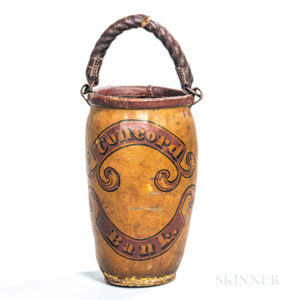 By Anne Gilbert
By Anne Gilbert America’s firemen have a long and exciting history that dates before the American Revolution when they were volunteers. It wasn’t until after the steam engine came into use in 1852 that fire fighters became paid professionals. Fortunately for historians and collectors many of their early artifacts have survived. Surprisingly, when they make a rare auction appearance prices are often affordable.
Collectors have had a long love affair with fire fighting memorabilia that includes everything from fire buckets, parade helmets and trumpets to daguerreotypes and sheet music daguerreotypes and even sheet music.
Their equipment is equally collectible and includes fire engines. hoses and carts.
The earliest items available to collectors usually dates from the early 19th century. It was those fire-fighting methods that have left us our most interesting and valuable collectibles .
Consider the leather buckets once used to carry water from nearby water sources to the fires. In the Colonies leather buckets were made by the local cobblers that were the only means to carry water to the fire sites. They held about three gallons of water and were passed hand by hand by lines of sturdy male volunteers. When empty they were returned by another line of boys and women to be refilled.
The buckets were painted and gilded with bright colors and patriotic symbols and identified the fire company names and the date they were made. The most interesting have lavish illustrations.
By the mid-eighteenth century hand pumpers were in use. Fortunately over the decade’s new developments, such as gooseneck fire engines were in use.
The invention of the steam engine and hose reel in the mid-19th century saw the end of the bucket brigade. However, this early equipment was also painted and decorated. Ornate, iron hose holders are also important collectibles.
 The yearly fire fighters parade was an important occasion in cities and towns around the country in the late 19th century. The special items worn and used at the events are now very collectible. Famous artists such as Thomas Sully and Joseph Johnson were commissioned to paint panel motifs on engine panels.
The yearly fire fighters parade was an important occasion in cities and towns around the country in the late 19th century. The special items worn and used at the events are now very collectible. Famous artists such as Thomas Sully and Joseph Johnson were commissioned to paint panel motifs on engine panels. Presentation pieces awarded to fire departments include molded fire horns, brass nozzles, walking sticks, shields and signs. The dated and engraved horns and trumpets were usually of silver or silverplate.
Since the 1950s metal fire marks from the 1950s have been collected. Originally they were mounted on buildings to show that the buildings were covered by fire insurance. They were made of tin, brass, lead, cast iron, aluminum and zinc. Among the most interesting designs are those showing the early fire engines. The reproduction buckets can be recognized by flat leather strip handles.
PHOTOS: Antique leather fire bucket. Skinner Auctions; Antique metal fire marks. Skinner Auctions















Follow Us